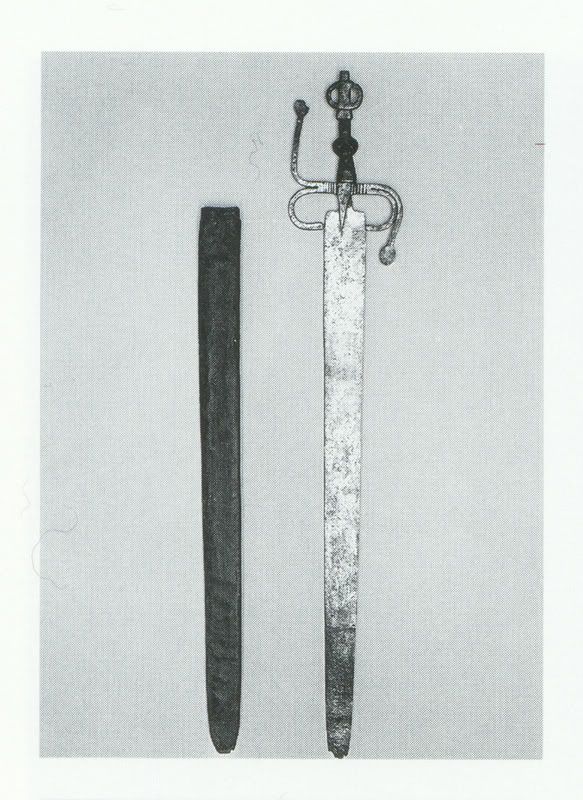
 |
|
|
|
|
#1 |
|
Member
Join Date: Dec 2004
Location: What is still UK
Posts: 5,807
|
Some more from "Armes traditionnelles d'Afrique" Found around Congo and Angola. As mentioned based on old swords but not that old in themselves.
|
|
|

|
|
|
#2 |
|
Member
Join Date: Dec 2004
Location: Italia
Posts: 1,243
|
Hello Brian, I will look forward to see your pics because since now I have seen just rusty examples on the web that are for sure not real weapons and not so old, but I have already said that there must be some older examples that were for the real use and that are the "prototype".
More on the book "Beauty in the blade" (Marc Leo Felix and Jan Elsen) there is said that these swords were produced still in recent times with the same "form" because they were also status symbol and so the shape of the blade and the hilt must remain the same over the centuries. From Beauty in the blade: Last edited by Flavio; 25th April 2007 at 07:06 PM. |
|
|

|
|
|
#3 |
|
Member
Join Date: Dec 2004
Location: Sint-Amandsberg (near Ghent, Belgium)
Posts: 830
|
Here I am, Flavio. Sorry, but I had to work
  Here's the translation from the book you mentioned earlier : The area of the Kongo-tribe had the earliest European influence in Congo. This was the first region where European weapons were introduced. Especially swords from Spain or Portugal were imported into the Kongo empire. And very soon, locals smiths took over the production of this type of sword. Due to the import of guns, local production of weapons declined. The only remainin witnesses are the rare swords which were used as symbols of authority by the rulers of the Kongo empire. ... A bit further the author continues : The handles of most swords have perished. But some still have an ivory handle. Not all of the sword blades were locally made. Some were of European origin ... In 'Dodelijk Mooi' (BeautÚ fatale or Deadly Beauty) the author states : In the vicinity of the Za´re (Kongo) estuary, a ceremonial sword can be found which is produced in imitation of old Portuguese swords. Here's a pic form 'Dodelijk mooi' (with sheath). local name : mbeele za lulendo materials used : iron, ivory, wood, leather collected in 1988 dimensions : 89,1 cm (sword) - 71,2 cm (sheath) collection of Jan Elsen 
|
|
|

|
|
|
#4 |
|
Member
Join Date: Dec 2004
Location: Italia
Posts: 1,243
|
Thank you very much Freddy

|
|
|

|
|
|
#5 |
|
(deceased)
Join Date: Dec 2004
Location: Portugal
Posts: 9,694
|
Hi Brian
No comparison possible between me and Marc. I am just less than an ignorant, while Marc is a master. But let's pretend that sword is actually of Portuguese influence or inheritance. As just said the other day in the thread signaled by Flavio, these Afro-Portuguese swords were originaly mounted by Portuguese resident smiths ( XV century ), but quickly imitated by the Congolese artisans. While the Portuguese production has soon ceased, the Congolese kept making them until the XIX century. It is of general knowledge that actual Portuguese specimens are very, very rare. On the other hand, the British Museum is a serious house. I would have no doubt that their example is real old, which doesn't avoid that it is a native made piece, from the early period. It is said that in both cases the blades were imported from Europe, which makes it dificult to distinguish either version, if it weren't for the hilt quality aspect. These swords have played an important role in Congo society, where the Kings got to be christianized.The Cross symbols being perforated in the superior quillons, besides the respect (?) reached by the Portuguese , made these swords achieve a symbolic status, becoming possession of local aristrocacy, still today called swords of authority. I have spotted these pictures the other day http://african-tribal-art-weapons.eu...g2_itemId=2631 http://african-tribal-art-weapons.eu...g2_itemId=2388 http://african-tribal-art-weapons.eu...g2_itemId=2633 http://african-tribal-art-weapons.eu...g2_itemId=2635 I am not at all an expert, but these examples's crudeness is well visible. I look forward to seing those pictures of yours, and so will the other experimented members. kind regards fernando |
|
|

|
|
|
#6 |
|
Member
Join Date: Dec 2004
Location: Madrid / Barcelona
Posts: 256
|
I'm afraid I'm far from being a "master" of anything, but you're also far from being an ignorant, Fernando
 This is extremely interesting. The original typology has already been discussed in the other thread, but the extent and the characteristics of this African production is a subject that deserves definitely a deeper study. The key element are the blades, probably. I would really like to be able to take a closer looks to some of them... Thanks for this info, gentlemen. |
|
|

|
|
|
#7 |
|
Member
Join Date: Jan 2005
Posts: 485
|
Sorry, I didnt get a chance to unload the images, and have left me camera at work!
Will definately do so early next week! I am very curious for an opinion from those that know, which of course would be easier from an image, and not my previous description. |
|
|

|
 |
|
|